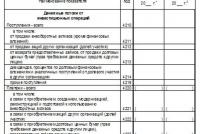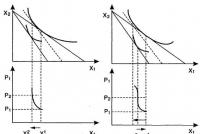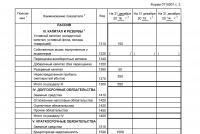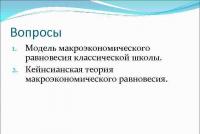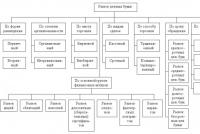Report on the movement of monetary documents sample. The cash flow statement is the procedure for filling out. Who, where and when submits the report
The procedure for filling out Form 4 "Cash Flow Statement" in the BukhSoft program: Enterprise
In the programs, all primary accounting forms, all accounting and tax reporting (including balance sheet form (form f-1)) in paper and electronic form are formed in MS Excel FOR FREE!
BukhSoft is a shareware program for automating accounting, management, personnel, warehouse, operational accounting, automating payroll, production, etc. You can evaluate the convenience and functionality of the programs yourself.
Download programs with tax reporting forms and accounting forms! >>
General information:
Filling in the balance sheet is carried out taking into account RAS 4/99 "Accounting statements of the organization" and the Order of the Ministry of Finance of the Russian Federation dated July 22, 03 No. 67n "On the forms of accounting statements"
Attention! The period for which the report is filled out must be indicated in the directory Information about the organization / Tab "For reports" (usually - a year).
The report is filled in thousand rubles. Rounding is done for each line, i.e. first, the sum of the corresponding account balances is calculated, and then the division by 1000 occurs.
The heading of the report is filled in according to the Information about the organization directory.
Period – filled in depending on the period selected in the Organization Details/ For Reports tab.
If the end date in the Organization Details for reports is March 31, then Form 2 will indicate “Quarter I” of the current year;
If the end date in the Information about the organization for reports is June 30, then Form 2 will indicate the "I half of the year" of the current year;
If the end date in the Organization Details for Reporting is September 30th, then "9 months" of the current year will be indicated"
If the end date in the Organization Information for reports is December 31, then the current year is “2004.”
If the end date differs from those listed, then the period will not be specified.
Date (year, month, day)
When filling in the date, the current date is written.
TIN is filled in according to the data specified in the Information about the organization
Organization - a short Name is written from the Information about the organization.
Type of activity - the type of activity is prescribed from the Information about the organization
Organizational and legal form - the organizational and legal form is prescribed from the Information about the organization
Unit of measurement - thousand rubles.
Filling in the column "For the reporting period"
Attention! The report is filled out according to the transaction log data for the period specified in the Organization Details. The data for the corresponding lines is generated as the sum of transactions for the selected period.
Line “Cash balance at the beginning of the reporting year”
It is filled in according to the data from the input of balances, represents the sum of balances as of 01/01/2005 on accounts 50, 51, 52, 55.
Line "Funds received from buyers, customers"
Calculated as the sum of transactions D 50, 51, 52, 55 K 62, 76.7, 76.10
Line "Other income"
Calculated as the sum of transactions D 50, 51, 52, 55 K 60.1, 60.2, 60.3
Line 150
Calculated as the difference between cash paid to suppliers and capital and financial investments received.
Line 160
Calculated as the sum of transactions D 69, 70 K 50, 51, 52, 55
Line 170
Calculated as the sum of transactions D 75 K 50, 51, 52, 55
Line 180
Calculated as the sum of transactions D 68 K 50, 51, 52, 55
Line "Other expenses"
Calculated as the sum of expenses for banking services
Line 210
It is calculated as the sum of transactions D10 K 91 "Receipts from other property" and transactions D any K 91 "Receipts from depreciable property"
Line 220 Calculated as the sum of postings D58 K 91 "Receipts from other property"
Line 230
Line 240
Calculated as the sum of transactions D76.3 K 91 “Receipts in the form of interest received under loan, credit, bank account agreements”
Line 250
Calculated as the sum of transactions D 50, 51, 52, 55 K 58 "Granted loans (long-term and short-term)"
Line 280
Calculated as the sum of transactions D 58.1 K 76
Line 290
Calculated as the sum of transactions D 08 K 60, 62, 76
Line 300
Calculated as the sum of transactions D 58.2, 58.3, 58.4, 58.5, 58.8, 58.9 K 60, 62, 76
Line 310
Calculated as the sum of transactions D 58.6, 58.7 K 50, 51, 52, 55
Line 340
This line reflects the difference between the funds received and spent on investment activities. To calculate it, you need to add the indicators of all previous lines without parentheses of the section "Cash flow from investing activities" and subtract the indicators of the same section, indicated in parentheses.
Line "Proceeds from the issue of shares or other equity securities"
Calculated as the sum of transactions D 75.1 K 83.2
Line "Receipts from loans and credits provided by other organizations"
Calculated as the sum of transactions D 50, 51, 52, 55 K 66, 67
Line "Repayment of financial lease obligations"
Calculated as the sum of postings D K 50, 51, 52, 55 K 76.13
Line "Net cash from financing activities"
This line should indicate the difference between the receipt and disposal of funds for the financial activities of the organization.
To find it, you should add the indicators of all previous lines without parentheses of the section "Cash flow from financial activities" and subtract the indicators of the same section, enclosed in parentheses.
Filling in the column "For the same period of the previous year"
The column is filled in according to the same rules as “For the reporting period”, provided that the data was imported from the 2004 version.
The fourth report of the financial statements is the cash flow statement, which shows the change in such an indicator of the balance sheet as cash. Form 4 supplements the balance sheet and provides details on the movement of cash flows in the reporting year.
The form of the cash flow statement, relevant in 2016, was approved by Order of the Ministry of Finance of Russia No. 66n dated July 2, 2010, as amended. Orders of the Ministry of Finance of Russia dated 17.08.2012 No. 113n, dated 06.04.2015 No. 57n. The form provided in the appendix to this order should be used when filling out the report for 2015.
Cash flow statement form 4 2016 - .
|
|
|
Who, where and when submits the report?
Who is giving up?
Form 4 must be completed by all legal entities except for those listed below:
- small businesses;
- microenterprises;
- Insurance companies;
- budget institutions;
- credit organizations.
For all other organizations, the report is a mandatory component of financial statements.
Where and when to donate?
The cash flow statement form is filled out in two copies, each copy is signed by the head of the organization and submitted to the Federal Tax Service and Rosstat. In the Federal Tax Service, the report should be submitted to the department in which the organization is registered. You should also submit a document to Rosstat at the place of registration.
Small businesses can fill out .
Rules for filling in 2016
- Form 4 is completed for 2 consecutive years - the reporting year and the previous one;
- data are given at the end of the year;
- amounts are rounded to the nearest thousand or million rubles;
- the amounts are shown excluding value added tax and excises;
- sums with a minus sign are written in parentheses (expenses, payments);
- data for filling are taken from cash accounts.
As an example, below is the procedure for filling out a report for 2015. A completed sample form 4 can be downloaded at the bottom of the article.
Sample filling for 2015
The statement of cash flows details line 250 of the balance sheet. The data is taken from the accounts of cash (account 50), non-cash (account 51), foreign currency (account 52), special bank accounts (account 55), transfers in transit (account 57). The debit of these accounts reflects the receipt of funds, credit - their reduction.
All funds are distributed in three streams:
- current;
- investment;
- financial.
If it is not possible to clearly attribute the transaction to one of the three types of flow, then it should be entered in line 4119 (for receipts) or 4219 (for payments).
Each stream consists of two subsections, the first one shows the total amount of receipts in this direction, then the amount is detailed; in the second, the total amount of payments is given and its breakdown is given.
Cash flows from current operations
 Receipts and payments related to the ordinary activities of the enterprise.
Receipts and payments related to the ordinary activities of the enterprise.
These incomes include income received from:
- sales of products, goods, provision of services, performance of work;
- leasing property;
- resale of financial investments and others.
Payments for current operations include expenses in connection with:
- payment of invoices to suppliers;
- wages of employees;
- payment of loan interest;
- payment of taxes and other payments.
Line 4110 indicates the total amount of receipts for 2015 and 2014, line 4120 - the total amount of payments. In line 4100 - the difference between these indicators is calculated (the balance of cash flows from current operations is displayed.
An example of filling out this section can be seen in the screenshot above.
Cash flows from investment operations
 Receipts and payments are reflected in connection with the movement of fixed assets and intangible assets, loans, loans.
Receipts and payments are reflected in connection with the movement of fixed assets and intangible assets, loans, loans.
Receipts of funds are possible in connection with the following operations:
- sale of fixed assets and intangible assets;
- sale of shares and shares in the authorized capital of other organizations;
- return of loans;
- dividends from participation in the capital of other organizations and others.
Payments that can be attributed to this line of cash flows can be caused by the following transactions:
- modernization, reconstruction, creation, acquisition of fixed assets and intangible assets;
- participation in the capital of other organizations (purchase of shares, shares in the UK);
- provision of loans, purchase of debt securities;
- payment of interest on debts and other payments.
Line 4210 indicates the total amount of cash receipts from these operations, line 4220 - the total amount of payments. In line 4200, the balance is calculated (line 4220 is subtracted from line 4210).
An example of filling out this section can be seen in the screenshot above.
Cash flows from financial transactions
 Income from financial operations includes receipts from the following operations:
Income from financial operations includes receipts from the following operations:
- obtaining loans;
- contributions from members of the company in the form of cash;
- income from shares, increase in the UK;
- income from the issuance of new bonds, bills and other receipts.
Expenses from financial transactions:
- redemption of shares and shares from the participants of the company;
- payment of dividends;
- redemption of bills;
- repayment of loans, etc.
In line 4310, the total amount of receipts for the specified operations is written, in line 4320 - the total amount of payments. Page 4300 shows the final balance of cash flows from financial transactions.
An example of filling out the third section of form 4 can be seen in the screenshot above.
4400 - add up the balance of all transactions that caused the movement of funds (4100 plus 4200 plus 4300).
4450 - the balance of funds at the beginning of the year.
The cash flow statement (ODFS) reflects cash flows and balances of cash and cash equivalents at the beginning and end of the reporting period. Let's remember what the form of the cash flow statement looks like, and also present an example of filling it out.
Cash flow statement: form
For the cash flow statement, the form was approved by Order of the Ministry of Finance dated July 2, 2010 No. 66n.
Cash flow statement: .
If ODDS is needed in Word format, you can download it below.
Cash flow statement:
For presentation on paper, the 2018 cash flow statement form in a machine-readable form in PDF format can be downloaded as part of a set of accounting (financial) statements at.
The procedure for generating a cash flow statement is provided for by PBU 23/2011.
Cash flow statement: an example of filling out
Let's give for f 4 of the cash flow statement a sample of its filling on conditional digital data.
We will present the summary data on cash balances and cash flow operations in the table:
| Indicator | Amount (thousand rubles) | |
|---|---|---|
| 2017 | 2018 | |
| Cash balance at the beginning of the year | 2396 | 17867 |
| Revenue received from buyers (including VAT 18%) | 725368 | 938022 |
| Received a bank loan | 6000 | — |
| Proceeds from the sale of fixed assets (including VAT 18%) | 96 | — |
| Proceeds in the form of a repaid loan from another organization | — | 36000 |
| Interest income under a loan agreement | 1206 | 3219 |
| Payments to suppliers (including VAT 18%) | 625113 | 897402 |
| Wages paid to employees | 11082 | 13778 |
| Transferred personal income tax from the salary of employees | 1656 | 2059 |
| Insurance premiums from the wages of employees are listed | 2801 | 4011 |
| Interest paid on a loan agreement | 318 | 726 |
| Income tax paid | 12302 | 19011 |
| Transferred VAT to the budget | 23927 | 36764 |
| Loan granted to another organization | 40000 | — |
| Bank loan repaid | — | 6000 |
| Cash balance at the end of the year | 17867 | 15357 |
For the purposes of filling out the ODDS, we will make adjustments for VAT.
In the cash flow statement in form N 4, information is generated on the organization's cash flow in the currency of Russia and in foreign currency. Cash flow data are provided for the reporting and previous year. The report is prepared in the official currency of the Russian Federation rubles. However, the unit of measurement of rubles - thousands or millions - is the same as in the balance sheet. Form code according to OKUD 0710004.
Go to the cash flow statement form used from .
The report is built according to the balance principle: the balance at the beginning of the reporting period plus receipts minus expenses equals the balance at the end of the reporting period.
The receipt and direction of funds are given in the context of current, investment and financial activities. Their definition is given in paragraph 15 of the Instructions on the procedure for compiling and submitting financial statements, approved by order of the Ministry of Finance of the Russian Federation dated July 22, 2003 No. 67n.
AT cash flow statement reflects the data directly arising from the entries in the accounting accounts of funds.
The source of information for the preparation of the Report is the data on the cash flow of the organization, accounted for in the accounts:
- 50 "Cashier";
- 51 "Settlement accounts";
- 52 "Currency accounts";
- 55 "Special accounts in banks" (with the exception of the balance of sub-account 55-3 "Deposit accounts");
- 57 "Transfers on the way".
The data should characterize changes in the financial position of the organization in the context of current, investment and financial activities.
The current activity is the activity of the organization, pursuing the extraction of profit as the main goal or not having the extraction of profit as such a goal in accordance with the subject and objectives of the activity, i.e. production of industrial and agricultural products, construction works, sale of goods, provision of public catering services, procurement of agricultural products, leasing of property, etc.
Investment activity is the activity of an organization related to the acquisition of land plots, buildings and other real estate, equipment, intangible assets and other non-current assets, as well as their sale; with the implementation of own construction, expenses for research, development and technological development; with the implementation of financial investments (acquisition of securities of other organizations, including debt, contributions to the authorized (share) capital of other organizations, provision of loans to other organizations, etc.).
Financial activity is the activity of an organization, as a result of which the size and composition of the organization's equity capital, borrowed funds (proceeds from the issue of shares, bonds, loans from other organizations, repayment of borrowed funds, etc.) change.
Information about the cash flow of the organization form N 4 are submitted in the currency of the Russian Federation. If there is (movement) of cash in foreign currency, information is generated on the movement of foreign currency for each of its types in relation to the cash flow statement adopted by the organization. After that, the data of each calculation, drawn up in foreign currency, are recalculated at the rate of the Central Bank of the Russian Federation as of the date of preparation of the financial statements. The data obtained for individual calculations are summarized when filling in the relevant indicators Cash flow statement.
A cash flow statement is a document that clearly reflects the structure of receipts and expenditures of cash flow. This data allows you to follow the development of the enterprise and visualize its future potential. This becomes possible due to the demonstration in the document of capital in three directions - current activities, investment and investments. Next, we will discuss how to fill out a cash flow statement.
General information
The form of the document was adopted in 2010 by order No. 66 of the Ministry of Finance. Almost all enterprises engaged in commercial activities are required to fill it out, with the exception of:
- State organizations.
- Insurance companies.
- credit companies.
The information entered in the document is of great importance both for the management of the enterprise and for other involved entities. These include: co-owners, investors, creditors and other persons. An analysis of the cash flow statement in Form 4 makes it possible to examine in detail the movement of the company's cash flows.
The report is formed annually and submitted to the bodies exercising control.
Document structure
The entire amount of information in the document is divided into several blocks by type of activity:
- Main.
- Investment.
- Financial.
Using this method allows you to demonstrate the true financial picture for each of the areas. The isolation of each of them in a separate block makes it possible to exclude the situation of concealing unprofitability for one of the types of activity by summarizing the amount of the total cash flow. These areas of analysis create a structure from which the cash flow statement form is subsequently formed.
Primary activity
This section includes all activities leading to the receipt of income from the implementation of the main activities of the institution. It includes:
- Net profit and loss associated with the conduct of the main course of business.
- Management expenses.
- Payment of wages.
- The cost of paying commissions, interest and income tax.
- Dividends in the cash flow statement, etc.
Investment activities
This includes all ongoing operations that result in long-term benefits. In particular, investments in assets in several areas are taken into account:
- Purchase and/or sale of subsidiaries.
- Acquisition of real estate in order to extract long-term benefits.
- Purchase / sale of non-negotiable assets and funds for the production process.

Financial activities
This chapter of the cash flow statement contains information on the changes in the volume and structure of the net asset of the enterprise and borrowed funds:
- Issuance of any type of shares and redemption from their holders.
- Dividends paid.
- Income from the sale of debts.
The posted structure should be regarded as an example of a cash flow statement. Each institution independently describes the level of detail and composition of the report within the framework of the adopted structure. Some items are subject to change. Be careful!
Report Creation Techniques
Don't know how to fill out a cash flow statement? In practice, there are two types of generating a detailed report. Each of these methods for creating an organization's cash flow document and how to complete the form are based on the specified structure.
Features of the direct method
Reporting involves the provision of information of various kinds on receipts and expenditures that are directly related to the implementation of the main tasks of the enterprise. Information is collected from the following sources:
- Information about the profit and loss of the organization and balance sheet.
- Company accounts.
The first option is the most common and simple. The second one is rarely used in practice due to its complexity. This requires classifying and analyzing a very large amount of information.
The process of generating a cash flow statement for internal accounting is not an easy task. In addition, the process is complicated by restricting access to some information. This prevents stakeholders from fully assessing all important aspects.
The disadvantage of the method is the inability to trace the relationship between changes in the total amount of available funds and the monetary result for the required period.
Before deciding how to fill out a cash flow statement, it is recommended to understand the nuances of each method. This method has the following advantages:
- The ability to track where the cash flow comes from and where it goes.
- Good understanding of the extent to which available funds can cover current liabilities.
- Linking the report to the current income and expenditure budget.
- Tracking the relationship between expenses and income.
The material contained in the cash flow statement (an example can be seen in the photo below) is necessary to assess the liquidity of the organization in the context of long-term analysis. This opportunity opens up thanks to a detailed consideration of the movement of funds in three main directions.

indirect method
This method of reporting involves the use of documentation related to the main activity.
Thinking about how to fill out a cash flow statement? The principle of constructing a report by the indirect method is the opposite of the previous one. The work consists of the following stages:
- Determination of the amount of profit in its pure form on the basis of relevant documents.
- The addition of net income and expenses that do not affect the movement of funds.
- Summation and calculation of changes in expenses for current payments, with the exception of the "financial payments" section.
- Adding and calculating data on transactions involving short-term obligations that do not involve the payment of interest.
- The relationship between different areas and activities of the company.
- Relationship between net profit and working capital.
Step by step guide to filling out the report
In the financial statements, the cash flow statement, as noted earlier, is customary to classify all financial movements into three categories: current, cash and investment. Information is entered on the basis of balance data in the subgroup to which each specific operation belongs.

Current activities
The “cash income from current operations” part includes data that is responsible for the receipt and expenditure of funds associated with the main activity of the institution. Let's analyze the cash flow statement line by line:
Income:
- rent, royalties, fees, commissions and other charges of a similar nature;
- interest on receivables from customers and consumers;
- resale of material investments and so on (including the final balance of value added tax).
- wages to employees;
- income tax;
- commission on credit and borrowing obligations (except for those related to the value of investment assets);
- other expenses directly related to the implementation of the current activities of the institution.
The balance of financial receipts from current activities (profit minus payments).
Income from current operations.
This figure in the statement of cash flows is calculated as the result of adding points 4111 to 4119.
- Item 4110 - total receipts for a specified period of time.
- Item 4111 - this column contains the total accruals of funds received from current operations.
Information is taken from the following debit accounting registers:
- The fiftieth - "Cashier".
These indicators are reflected in the statement of cash flow minus indirect taxes, amounts accepted by agents, intermediaries, commission agents and transfers received on account of compensation payments (utility payments, motor transport expenses and much more).
- Item 4112 - rent, licenses, commissions, royalties.
- Item 4113 - resale of tangible assets.
- Items 4114 through 4118 are optional. In them, the financier can reflect amounts that cannot be clearly classified. These indicators are reproduced according to the same principle that was used in line 4111.
- Item 4119 - other types of income from the implementation of entrepreneurial activities.
These include the following:
- benefit received from the acquisition/realization of currency;
- a positive indicator of the balance of VAT payments;
- return funds;
- interest on receivables from clients and customers;
- profit from the sale of other property that is not directly related to the funds placed on the balance sheet of the company.
These figures are reflected in the same way as in line 4111. Indirect taxes received by the enterprise from the budget (for example, value added tax refunds) are entered in the “curtailed” column.

Filling the section on current payments
These components of the statement of cash flows are calculated as a set of points from 4121 to 4129. The data for these periods are enclosed in parentheses.
- Item 4120 - general expenses.
- Item 4121 - settlement with suppliers.
Information is reflected in the accounting registers for the loan of the following accounts:
- The fiftieth - "Cashier".
- Fifty-first - "Settlement Accounts".
- Fifty-second - "Currency Accounts".
- Fifty-eighth - "Investment".
- Seventy-sixth - "Payments to debtors and creditors."
It is necessary to reproduce this information in the documentation with the withholding of indirect taxes, payments to agents, commitents and intermediaries, as well as reimbursable expenses for utility bills and transport.
- Item 4122 - transfer of wages to employees. Information is indicated according to the same principle as in paragraph 4121.
- Item 4123 - interest on credit and loan agreements.
- Item 4124 - income tax.
- Item from 4125 to 4128 - additional columns. At this point, the accountant can specify values that are difficult to type in other sections of the document. The amounts of these payments are paid on the same basis as payments with suppliers and contractors, that is, as specified in paragraph 4121.
- Item 4129 - the amount of other types of payments associated with the implementation of entrepreneurial activities.
These include:
- damage from the acquisition / sale of currency;
- losses acquired during the exchange of banknotes;
- the estimated balance of value added tax with a minus indicator / debt obligations to state bodies;
- penalties paid by the company, penalties and other payments of a similar kind, under contracts with counterparties.
Do you think that in this block the procedure for compiling a cash flow statement is changing? No, all these figures are displayed in the same way as the amounts of payments to suppliers and contractors, that is, as in paragraph 4121.
The amount of indirect tax transferred by the enterprise to the budget (for example, value added tax) for this item is displayed in the “minimized” line.
- Item 4100 - the balance of cash receipts from current operations. This includes the difference between income and expenses from core activities. Indicator 4110 = item 4110 - item 4120. When receiving a number with a negative indicator, it must be enclosed in parentheses.

Investment profit
The amount of proceeds from investment operations is the sum of the indicators reflected in paragraphs 4211 to 4219 of the cash flow statement. The decoding of paragraph 4210 indicates the total income.
- Item 4211 - non-current assets (except for material investments).
This type of income includes:
- fixed assets of the institution;
- non-financial assets;
- serious investments in non-current assets (for example, construction in progress);
- R&D results.
This data should be reflected in the documentation minus indirect taxes, funds paid to agents, principals and intermediaries, as well as reimbursable expenses for utilities and transportation costs.
- Item 4212 - income from the sale of shares or shares in other companies.
- Item 4213 - return of previously issued interest-bearing loans, sale of IOUs and bonds (the amount of interest received is not recorded in the report).
- Item 4214 - interest on debt financial investments and similar income from equity participation in other projects.
- Item 4219 - other transfers that relate to investment activities.
Payment transactions for investment projects
The amount of payments for investment transactions is made up of indicators from paragraphs 4221 to 4229. All figures are indicated in rounded brackets.
- Item 4220 is the total amount related to investment payments.
- Item 4221 is the purchase, formation, restoration, improvement or preparation for use of non-current assets. Not sure which accounts show up on the cash flow statement?
Information is entered in the accounting registers for the credit of the following accounts:
- The fiftieth - "Cashier".
- Fifty-first - "Settlement Accounts".
- Fifty-second - "Currency Accounts".
- Fifty-eighth - "Investment".
- Seventy-sixth - "Payments to debtors and creditors."
It is necessary to reflect this data in the documentation minus indirect taxes, funds transferred to agents, committents and intermediaries, as well as reimbursable expenses for utilities and transportation costs.
- Item 4222 - Acquisition of shares or interests in other companies.
- Item 4223 - acquisition of IOUs (the right to claim funds from third parties), the issuance of loan loans to other persons.
- Item 4224 - payment of interest on credit obligations included in the amount of the investment asset.
- Item 4229 - other payments.
These include:
- tax on income from investment operations;
- amounts invested in joint activities;
- other payments related to investment activities.
Item 4200 - balance of financial receipts from investment projects. This column contains the value of the amount that is obtained after deducting expenses from income from investment operations. That is, you must specify the difference.
Thinking about how to check the cash flow statement? The seventh indicator in this list is very easy to check: point 4200 = point 4210 - point 4220.
If a negative result is obtained, the value must be enclosed in parentheses.

Cash transactions
This section of the cash flow statement displays the amounts that have been raised by raising funds through debt or equity financing. Actions of this kind are accompanied by a change in size and structure:
- The financial condition of the enterprise.
- Borrowed funds of the company.
Filling in the section on receipts
The total amount of this value is obtained by adding columns 4311 to 4319.
- Item 4310 is a general indicator.
- Item 4311 - Obtaining credit or borrowed funds.
- Item 4312 - cash investments of owners.
- Item 4313 - receipt of funds from the issue of shares or the increase of participation interests.
- Item 4314 is cash flow from bills of exchange issued by the company, issuance of bonds and IOUs.
- Item 4319 - other receipts.
Payments for cash transactions
The total amount is calculated as the total from adding the values in items 4321 to 4329. All data must be indicated in brackets.
- Item 4320 is a general meaning.
- Item 4321 - Payments to owners on the repurchase of their shares or shares of the company, or by reason of their withdrawal from the founders.
- Item 4322 - Dividends and other payments to owners related to the distribution of profits.
- Item 4323 - redemption / redemption of bills and promissory notes, payments on loans and loan agreements.
- Item 4329 - other payments associated with monetary transactions.
- Item 4300 is the balance of cash flows from financial transactions. It is calculated according to the following scheme: item 4300 = item 4310 - item 4320. If you get a result with a minus sign, put parentheses.
Conclusion
Compilation and analysis of the cash flow statement in form 4, which provides a detailed picture of the movement of funds, in combination with other types of reporting, plays a significant role in understanding the real state of affairs of the company. The information contained in the document makes it possible to analyze the current state of affairs, predict future prospects and think about measures to improve efficiency. The choice of reporting method depends on the degree of availability of the required data.



